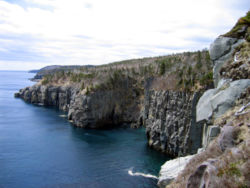Avalon Peninsula
 Satellite view of the Avalon Peninsula in the winter | |
Location of the Avalon Peninsula in Newfoundland | |
| Geography | |
|---|---|
| Location | North America |
| Adjacent to | Atlantic Ocean |
| Area | 9,220.61 km2 (3,560.10 sq mi) |
| Administration | |
Canada | |
| Demographics | |
| Population | 270,348 (2016) |
The Avalon Peninsula (French: Péninsule d'Avalon) is a large peninsula that makes up the southeast portion of the island of Newfoundland in Canada. It is 9,220.61 square kilometres (3,560.10 sq mi) in size.[1]
The peninsula is home to 270,348 people, about 52% of
) have long been the centre of Newfoundland's fishing industry.Geography and geology

The Avalon Peninsula is pinched into smaller peninsulas formed by St. Mary's Bay and Conception Bay. St. John's is located in the northeast of the peninsula.
The Avalon Peninsula is a noted region for
History
In 1497, explorer
Sir George Calvert was later given a large land holding on the peninsula in 1619 from William Vaughan, whose previous colony of Cambriol failed. The initial colony of Ferryland grew to a population of 100, becoming the first successful permanent settlement on Newfoundland island. In 1623 Calvert was given a royal charter extending the royal lands and granting them the name Province of Avalon "in imitation of Old Avalon in Somersetshire wherein Glassenbury stands, the first fruits of Christianity in Britain as the other was in that party of America". Calvert wished to make the colony a refuge for Roman Catholics facing persecution in England. In 1625, Calvert was elevated to the Peerage of Ireland as the 1st Baron Baltimore.
A series of crises and calamities led Lord Baltimore to quit the colony in 1629 for "some other warmer climate of this new world", which turned out to be
In 1696, during
During Queen Anne's War, Commodore John Leake of the Royal Navy led an expedition aimed at capturing French ships around the peninsula and burning French settlements. The expedition was largely successful. During this same conflict, the French attempted to besiege the fortified English port of St. John's, but were unsuccessful. They later returned and captured the town, burning it to the ground.
In the late eighteenth century, the longstanding rivalry between Great Britain and France erupted again in the Seven Years' War. It was fought in the North American colonies as well, where it was known to British colonists as the French and Indian War. The Battle of Signal Hill was fought on the peninsula in 1762. In this engagement, British soldiers and artillery under the command of William Amherst drove the French occupants of St. John's from Signal Hill and into the town's fort, where they soon surrendered.
See also
References
- ^ "Avalon Peninsula". The Canadian Encyclopedia. Archived March 7, 2008, at the Wayback Machine
- ^ "Census Profile - Avalon Peninsula". Statistics Canada. 8 February 2012. Retrieved 6 January 2013.

